When To Draft A QB2 On An Elite QB Team
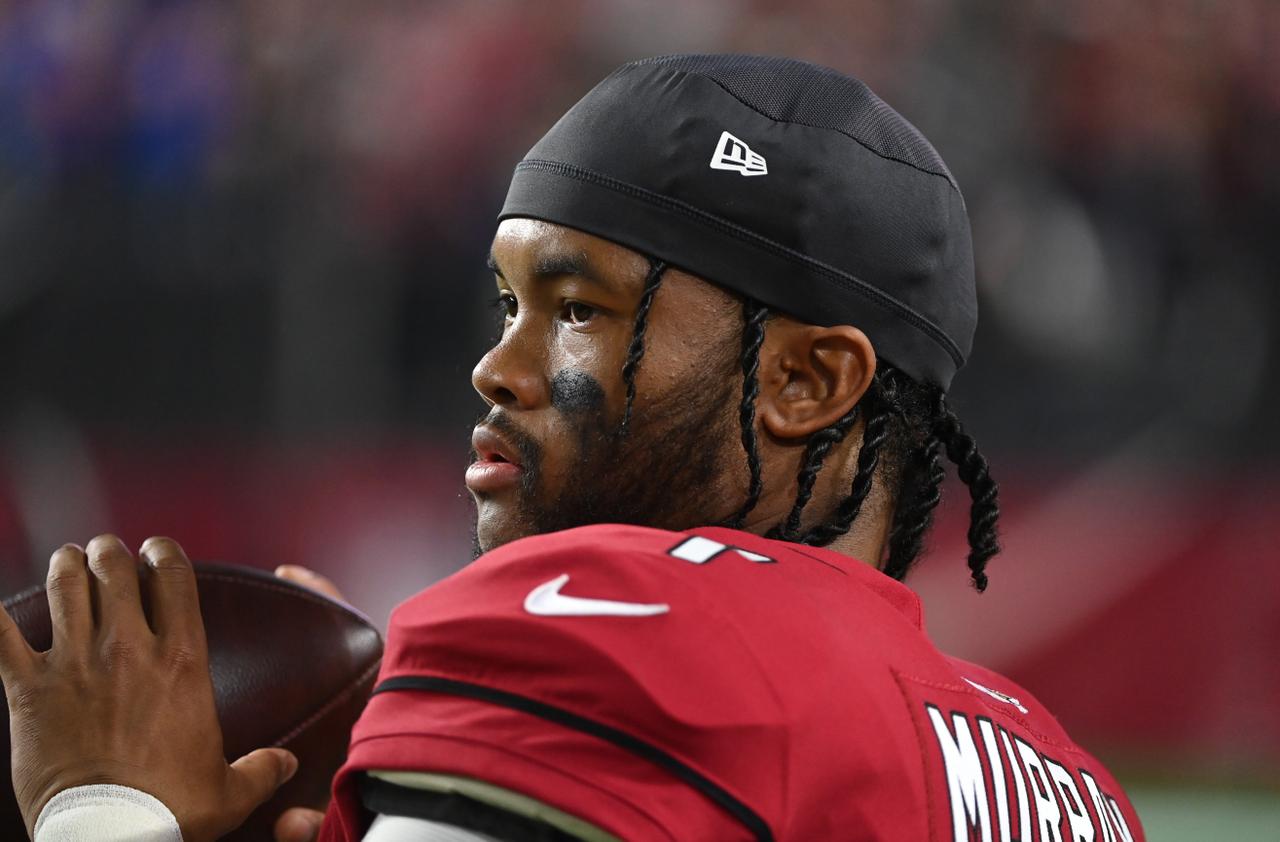
When I do new stuff, I make mistakes. And I think that happened in some of the analysis I did in my latest column. It’s a byproduct of pushing the envelope, so I’m okay with it. But it’s time to correct it (with some more thoughts attached).
Best ball analysis is evolving very fast because of a handful of people who are actually willing to put the work out, and I envision it continuing to evolve rapidly. For example, I think the debates of roster construction through the lens of 18 or 20 rounds will be amateur hour (hopefully as soon as this column). Why is this? There are too many avenues to get to a 2-5-8-3 to know if it was actually a smart build versus one that just looks good because it’s in the passable threshold through this wide-view lens.
In order to actually get some actionable content, the future will be contingent-based analysis. “If I did this, then what should I do for the rest of the draft?” I attempted to do this for the first time last week when I wrote “I Drafted A Stud QB. Do I Need A QB3 Still?” But upon more reflection, it wasn’t anywhere near specific enough. I tried to fit all Josh Allen teams into 2QB versus 3QB, but when that second quarterback is drafted clearly matters (among other things).
Moving forward, I want to take my time and answer each one of these problems one at a time. By doing this, there will be smaller samples, but that doesn’t mean they are worthless. If there is context added to it, then they will be informative. If it’s the type of analysis that is actually answering the questions we are looking for, then it’s worth pursuing. Don’t let perfection be the enemy of progress.
The QB2 Case Study
Question: I just drafted an early-round QB and want to have a ton of upside for my team. When should I draft my QB2?
Sample: 2021 Josh Allen teams and 2020 Kyler Murray teams because they finished QB1 and QB2 overall in their respective seasons as 48th (QB2 in ADP) and 72nd overall (QB4 in ADP) picks. If you nail an early-round quarterback, this is the type of season we are talking about.
Let’s get to the round-by-round results.
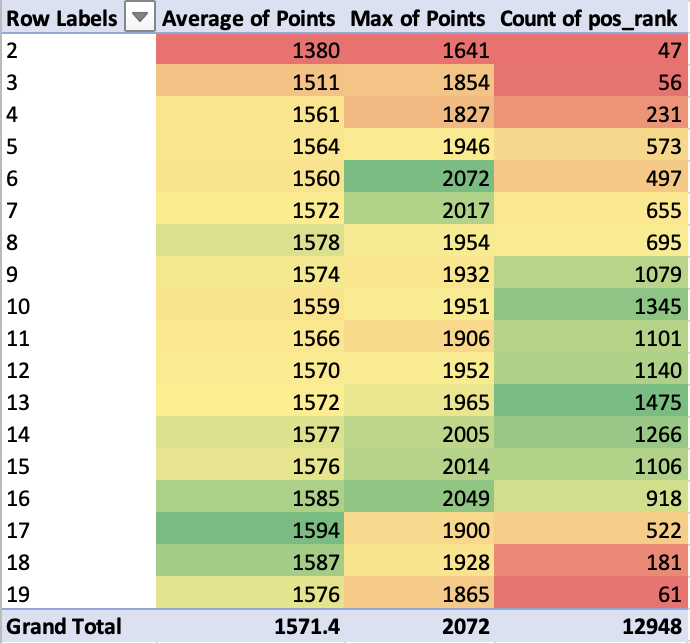
2021 Josh Allen teams’ points scored per week:
If QB2 was drafted in Rounds 6-10: 1,568 (n = 4,217)
If QB2 was drafted in Rounds 11-14: 1,571 (n = 4,982)
If QB2 was drafted in Rounds 15-18: 1,585 (n = 2,727)
If QB2 wasn’t drafted at all: 1,576 (n = 61)
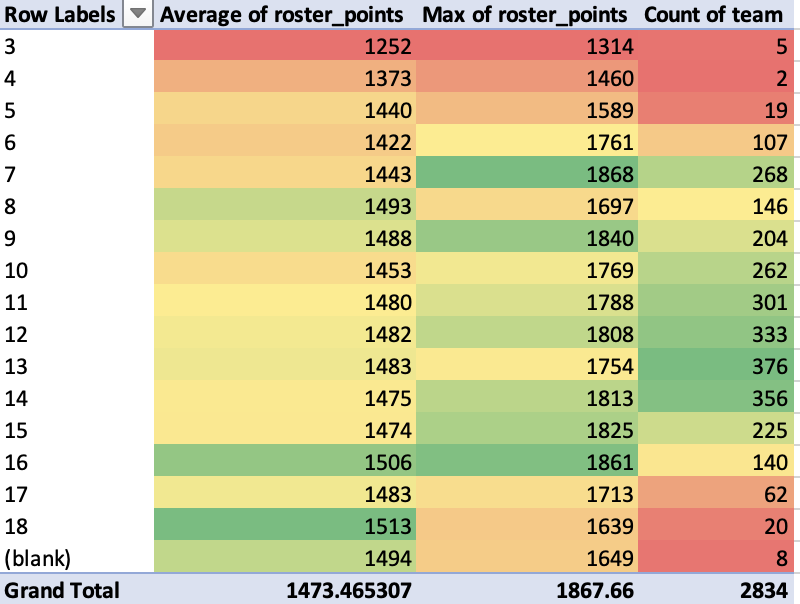
2020 Kyler Murray teams’ points scored per week:
If QB2 was drafted in Rounds 6-10: 1,467 (n = 725)
If QB2 was drafted in Rounds 11-14: 1,480 (n = 1,366)
If QB2 was drafted in Rounds 15-18: 1,487 (n = 447)
If QB2 wasn’t drafted at all: 1,494 (n = 8)
On the surface, it’s clear. Waiting on QB2 has been best when we hit on the elite quarterback season. 2021 Josh Allen teams and 2020 Kyler Murray teams both averaged the most points in their regular seasons when the QB2 was drafted in Rounds 15-18.
There are two caveats, however. Based on the content I’ve listened to, I’d argue that the drafters who were pushing the limits on their QB2 being so late in the draft are just smarter drafters in general. It’s not common sense to be so drastic in structure, so there could be a sample issue somewhat skewing the results towards later QB2s. I don’t think this impacts it all that much, but it’s possibly adding a few points on average.
The bigger caveat is how quarterbacks scored in these two seasons in general. If all of the quarterbacks drafted in Rounds 11-14 sucked, then of course these teams were best off avoiding them.
Let’s find a solution to this problem.
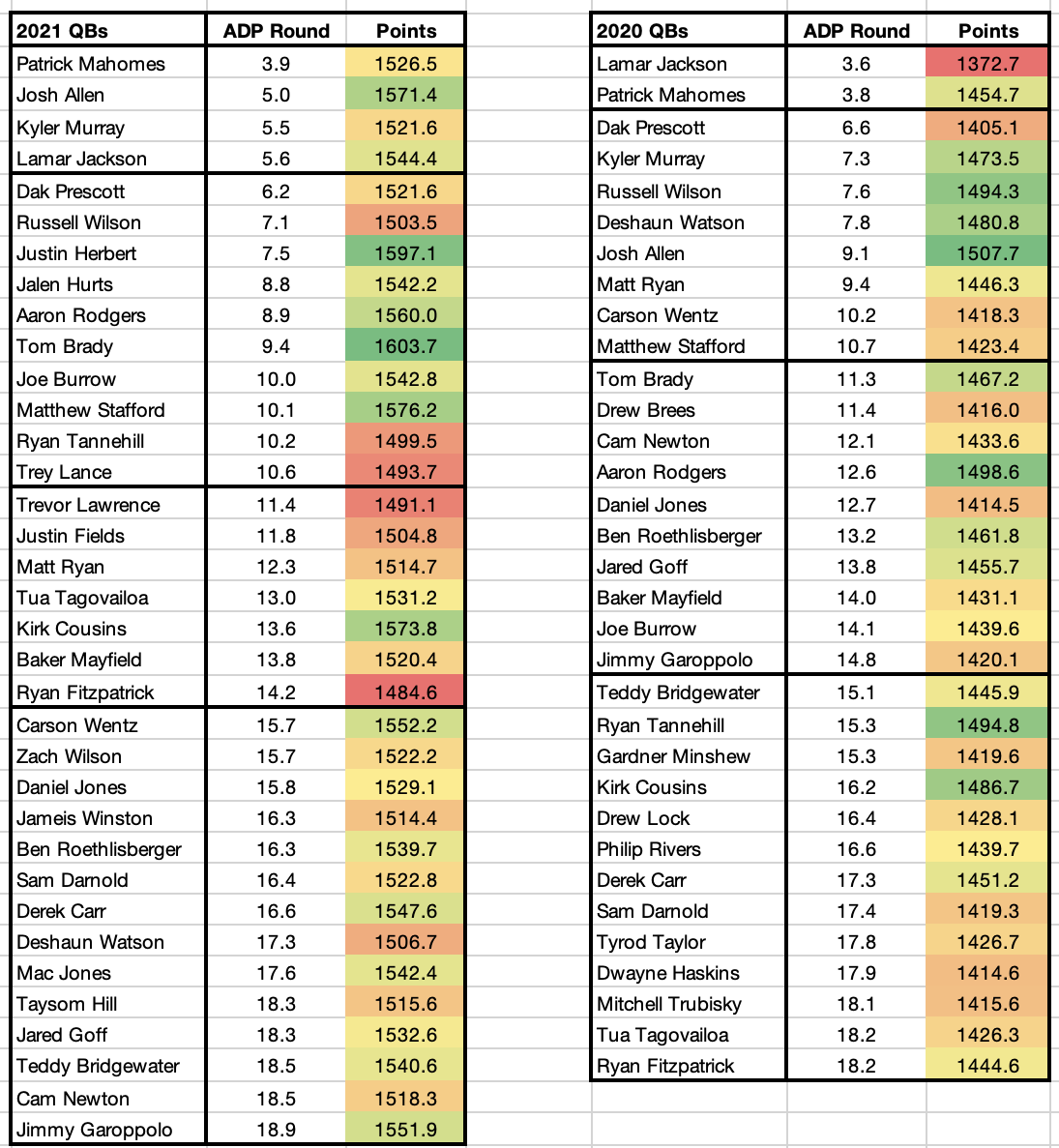
In both years, teams who drafted a quarterback in the Round 6-10 range averaged 12 or so more points than teams who drafted a quarterback in the Round 15-18 range. Despite this, the 2021 Josh Allen and 2020 Kyler Murray teams still averaged more points when the QB2 was drafted in the late-round range. This is reasonable evidence that there is cannibalization within two early-round quarterbacks when at least one of the quarterbacks are a league-winner like 2021 Josh Allen or 2020 Kyler Murray.
But we can go deeper than this and try to find the exact line when the opportunity cost of the second stud QB is stomach-able. For example, last year was it better to have Josh Allen with Justin Herbert as the QB2 (great pick in Round 7), or with Matthew Stafford as the QB2 (great pick in Round 10), or with Kirk Cousins as the QB2 (great pick in Round 13)?
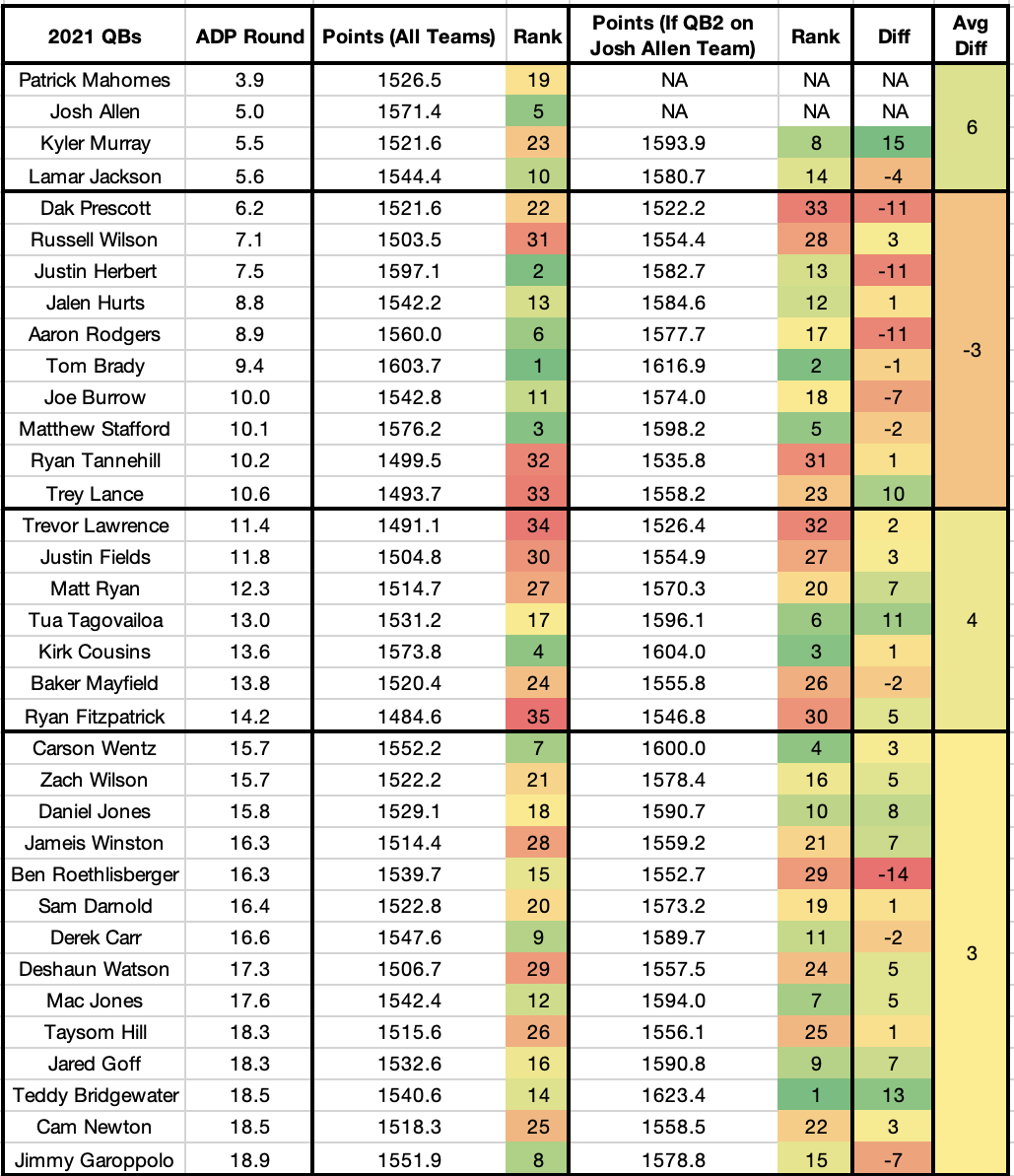
These “ranks” are how many points a team averaged if they had that quarterback, with the second rank column being how many points a team averaged if they had that quarterback as the QB2 on a Josh Allen team. The difference in the ranking shows if a quarterback was relatively better than the other quarterbacks with or without Josh Allen on the team. I’ll explain.
Let’s start near the top of the list. Both Lamar Jackson (5.6 round ADP) and Dak Prescott (6.2 round ADP) had tough seasons last year, but those seasons were relatively worse (10th vs. 14th and 22nd vs. 23rd) if they were the QB2 on a Josh Allen team. This is because these teams spent two top-six round picks on a position where you can start at most one of them per week. Justin Herbert (7.5 round ADP) was more evidence of this, as he went from ranking second among quarterbacks in value last year to 13th as Josh Allen’s QB2. This is evidence that the Round 3-7 range is too early when we’ve drafted a stud as our QB1. Ditto for Jalen Hurts and Aaron Rodgers.
Tom Brady (9.4 round ADP) is where the sweet spot begins. Brady’s ranking falls from first only down to second, and that’s including the small sample of Teddy Bridgewater teams that barely beat him out. In other words, among the most common quarterback pairings with Josh Allen, Tom Brady as the QB2 was the best. This cannibalization of two stud quarterbacks didn’t matter because Brady’s cost was after the range where receivers in particular tend to fall off. This range is further backed by Matthew Stafford’s (10.1 round ADP) minimal slide from third to fifth, too.
Without question, the Round 11-14 range is totally worth targeting on an early-round QB team. Last year’s ideal case in this range was Kirk Cousins (13.6 round ADP). His ranking jumped from fourth to third as Allen’s QB2, a signal that the opportunity cost of drafting a QB2 no longer existed. This was the case on average for the entire Round 11-18 range, which makes sense.
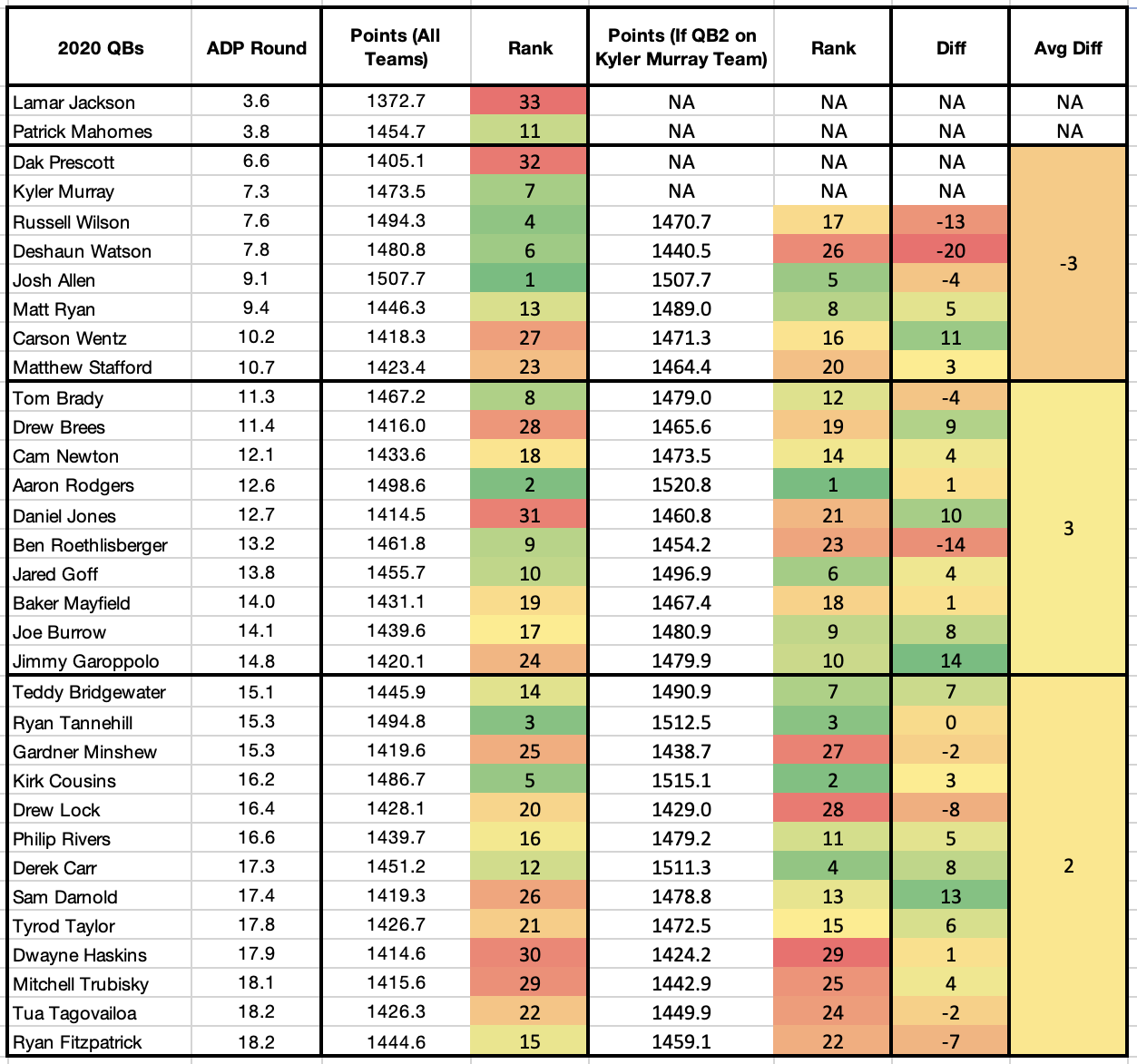
Back to 2020 Kyler Murray, but we’ll be quick here. … The valuable quarterbacks in the Round 9-12 range (Josh Allen, Matt Ryan, Tom Brady, and Aaron Rodgers) were basically just as valuable as Kyler’s QB2 as they were in general. Just as it was with 2021 Josh Allen, the Round 8-13 range where the opportunity cost of a second quarterback begins to be minimized. This is cool to see, as it backs up my “When Is It Optimal To Draft QBs” chart from the last two seasons:
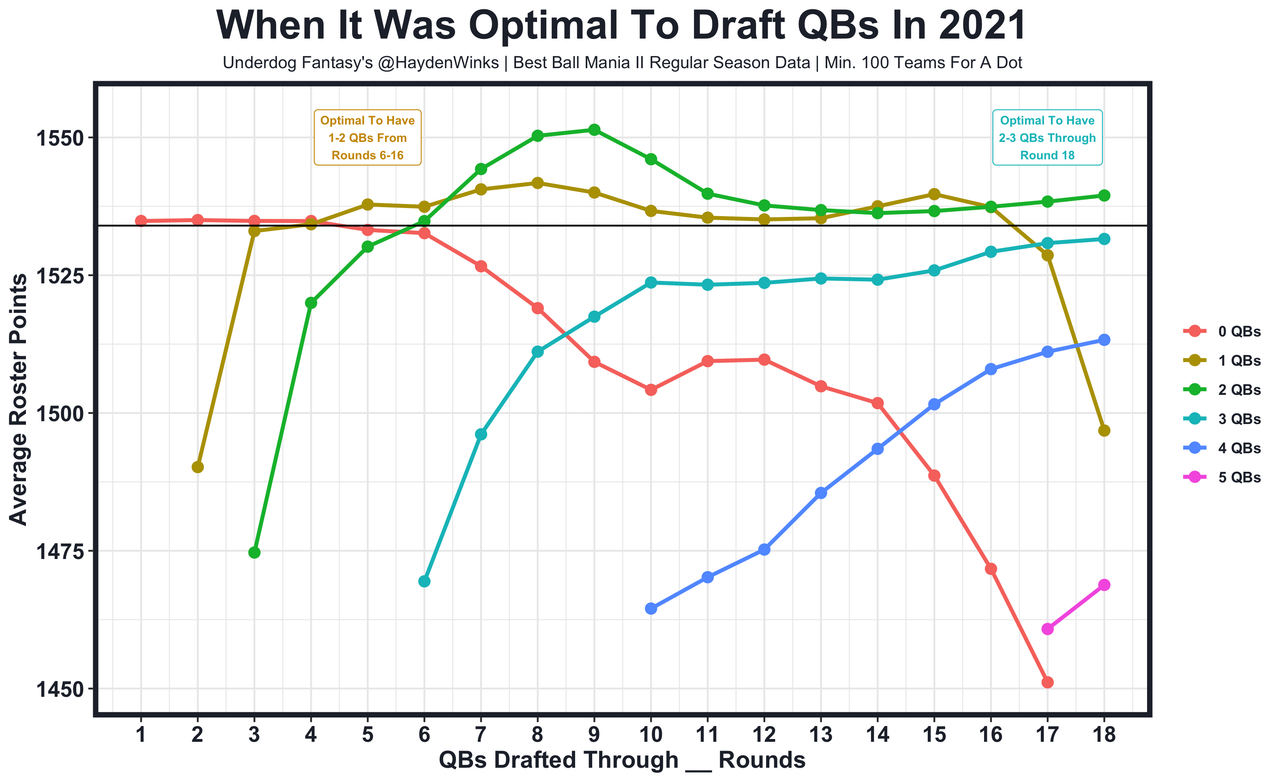
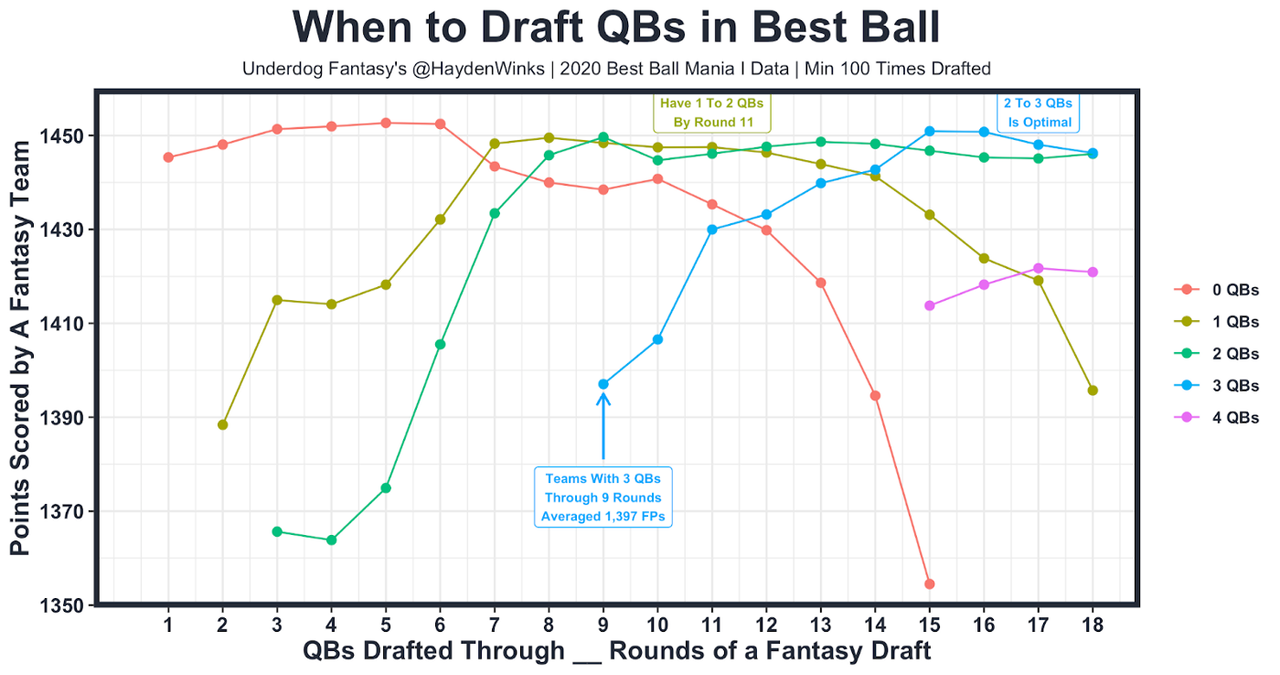
Conclusion
The future of best ball advice will be based on contingencies, and this QB2 column was a good example of the content I want to create moving forward. After doing these 2021 Josh Allen and 2020 Kyler Murray case studies, I believe the opportunity cost of drafting that second quarterback begins to be minimized somewhere in that Round 9 range. Drafting two quarterbacks before Round 7 was sub-optimal as a whole and was especially the case when one of the quarterbacks was a stud. This "when Player X is a stud" part is the lens we need to be thinking in when in the draft room. For best ball tournaments, assume the picks you are making are working out, and then build the best roster around it.
So if I've drafted a quarterback within the first six rounds, the earliest I'll be looking at QB2 will be in Round 8 or 9 knowing that waiting all the way until the Round 12-16 range can work, too.